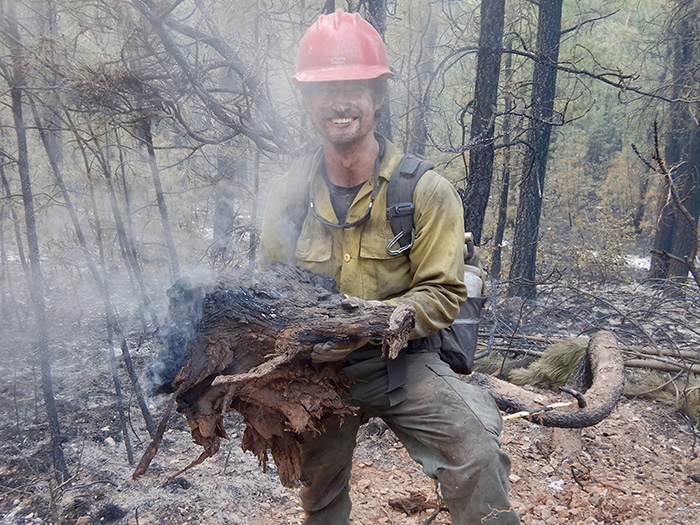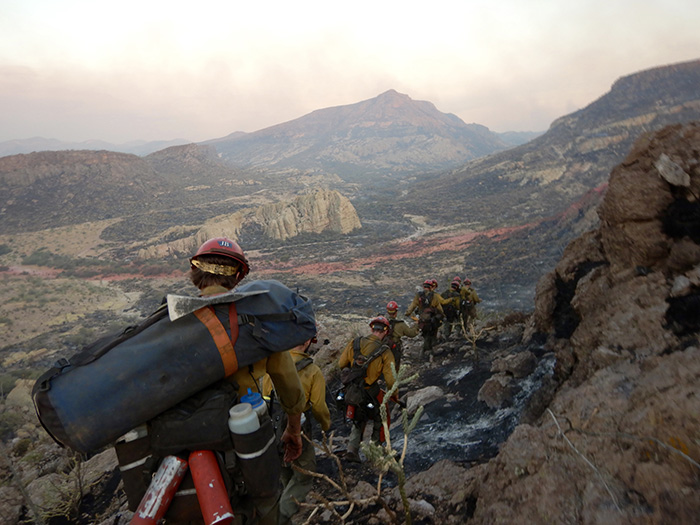Thon has a busy year battling fires
News | Published on November 10, 2021 at 11:52am EST | Author: Chad Koenen
0Frazee High School grad becomes a Hotshot firefighter

Shane Thon is the son of Gini and Paul Thon of Frazee. He is a Hotshot firefighter working for the federal government to battle high-priority fires.
By Barbie Porter
Editor
The National Interagency Fire Center reported 44,647 wildfires had burned more than 5.6 million acres in the United States so far in 2021. Shane Thon was one of many on the front lines beating back the fires.
The son of Paul and Gini Thon of Frazee has been tackling fires on behalf of the federal government the past five years. He said his co-workers, who has almost 20 years of experience, said the fire activity in the last five years has steadily broke records.
This past season, the largest scale fire Thon fought was in California. The state has faced an ongoing battle with fires where 8,239 fires were recorded in 2021 and 2.5 million acres burned. In the destructive path, 3,629 buildings were destroyed as of the end of October.

Shane Thon covers a lot of terrain for his work. The physicality of the job requires those working in the Hotshot division remain physically fit.
Thon was on the scene of the Monument Fire. Ignition was determined to be from a lightning strike at the end of July. Before it was contained 223,124 acres had burned.
Thon is a member of the Hotshot crew, which is a professional firefighter who helps tackle large-scale incidents around the U.S. They earned their moniker by working in the hottest part of the fire.
The Hotshot crew was formed in the 1930s alongside the Civilian Conservation Corps. By 1961 a formal group was developed and six 30-man crews were assigned to be on call for high-priority fires. Because the program was so effective, there are now more than 100 Hotshot crews across the nation.
Becoming a member of the Hotshot crew is no easy task. In addition to having extensive fire-fighting knowledge they must pass a stringent physical test. They must also agree to a spur of the moment schedule. Thon said he gets a few days off between calls, but after a short reprieve he is labeled as available.
“Once you go available, typically you get called in a day or so,” he said. “You get called, you go to the station and there is usually some travel time. Once you get there you work between 13-21 days, then go home and have a few days off before going out again. Sometimes you might get to stay home a week or so, it really depends on the need.”
When Thon arrived at the Monument Fire he checked in at the base operation site where he is briefed alongside other new coming firefighters on the scene before division assignments are handed out.
Thon said his jobs vary, but with the Monument Fire his division started a fire. Some may think starting a fire while trying to put one out is a ludicrous idea. But, the age-old and proven practice helps contain the fire. Thon explained his crew ignited a controlled fire that cleared up to 50 feet of brush and left a trail-like path. If the uncontrolled fire reached the path, it would not have the fuel to continue, unless it jumped across the pre-burnt ground.
“If the fire reaches that area, it will be easier to make the fire die down,” he said. “It is a common tactic.”
The work Thon is tasked with depends on his division’s assignment, which also determines the number of squad members. Typically, though, he said his squad has between six and eight firefighters.
“You’re always paired with another because the work is dangerous,” he said.
It can also be physically strenuous. This past season Thon was put to the task of carrying an 80 pound medical kit as they worked their way over steep terrain.
“My boss was standing on a hill above me and he very calmly told me to hurry up,” Thon said. “We had been hiking hard, but the fire was below us and moving up the hill fast.”
While that march on borrowed time was on dry ground, Thon said rains can make the soil slippery for the firefighters at times. Even in those conditions, the rain is a welcoming site.
“When it rains, if it is a big fire, 1/2 an inch will make a big difference,” he said. “There was one fire in Alaska where it rained for four days and pretty much put the fire out. We went back out to make sure and hardly found anything going.”
Regardless of the weather, when the Hotshots are on scene they often call the ground their bed.
“Typically we don’t set up tents,” he said. “There are times we get rained on. Once, it wasn’t supposed to rain and it started. We all just laid there thinking it would stop, but it kept going. By the time I woke up at 6 a.m. the next morning, everyone was wet and tired. We laughed about it.”
When it comes to career goals, Thon initially focused on becoming a smoke jumper. However, he found working in hot spots with the Hotshots to be very rewarding. Now, he doesn’t plan to pursue smoke jumping.
“I’m proud of what I’m doing now,” he said. “The injury with smoke jumping is high, so I won’t say never, but probably not.”
The fire season is roughly May through November, and during that time Thon is on call. He said the only option for a vacation request may be if an immediate family member is being married or something of that sort.
During the off-season, Thon said his peers have a variety of ways to live. Some take vacations and some work. Thon is in the latter group. He has picked various residences for the off-season and found various jobs.
“I normally winter in a ski town,” he said, adding jobs are plentiful.
When the fire season rolls around, Thon has steadily been re-hired for the Hotshot crew.
“If you do well, you pretty much can count on it,” he said.
At the age of 32, Thon envisions making a career out of being a Hotshot.

